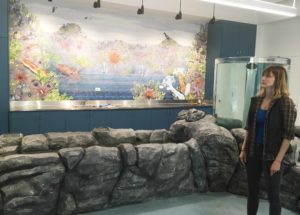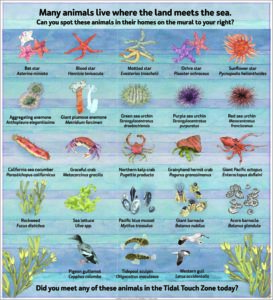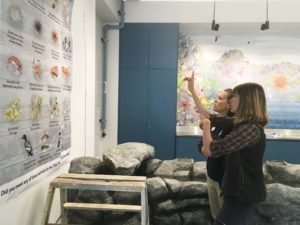In a corner of the Pacific Seas Aquarium, Maria Jost is putting up a poster. With guest engagement coordinator Amy Hale holding up one corner on a stepladder, Jost surveys the big paper proof for size and fit. Spotlit, the corner is a tiny island of human activity in an otherwise-underwater room: teal-swept walls, rock-edged touch tanks bubbling with water, a giant wall map of Puget Sound. It’s the Tidal Touch Zone, and the most arresting underwater image is one that Jost herself painted – the wall-sized “Where the Land Meets the Sea.”
Underwater watercolor
 “I’m really happy with how it looks in here,” says Jost, surveying the mural, which immerses the viewer in a delicate watercolor world of Puget Sound’s tidal zone, teeming with the crabs, urchins and sea stars that will be living right there in the touch tanks. “It captures the natural beauty of the Northwest, but also infuses some artistic magic.”
“I’m really happy with how it looks in here,” says Jost, surveying the mural, which immerses the viewer in a delicate watercolor world of Puget Sound’s tidal zone, teeming with the crabs, urchins and sea stars that will be living right there in the touch tanks. “It captures the natural beauty of the Northwest, but also infuses some artistic magic.”
Fifteen and a half feet wide and nearly seven feet high, the mural is, actually, wallpaper. Water-resistant, it’s a print-out of a digital collage that Jost assembled from dozens of hand-painted elements: gray rocky shore, purple spiky urchins, orange crabs and sea cucumbers, gray-blue mussels, green sea lettuce, clouds, water, seagulls, even a giant Pacific octopus. Each of the 23 different organisms is reproduced in a grid on the poster that Jost and Hale are sizing. Placed next to the touch tanks, it invites visitors (especially children) to see how many of those creatures and plants they can identity both in the big mural behind and in the tanks themselves.
Public art for all

“Where the Land Meets the Sea” is beautiful; a watery, windswept seascape that perfectly captures the ethereal light and pastel spectrum of the Pacific Northwest. It blends completely with the room, with the blue water echoed in the teal cabinets and ocean map, and the gray shoreline popping into three dimensions in the touch tank rockery. The overall feeling is of submersion – experiencing an underwater realm without actually getting wet (or cold!)
But this mural isn’t just a pretty picture. Jost was chosen for this work – a piece of public art paid for by the 1% for art mandated for all public works projects in Tacoma – because she’s not just an artist. She’s also a scientist. With a bachelor degree in biology and a master’s in science education under her belt, she works during the day as a science teacher at Tacoma’s Science and Math Institute, the high school that has a campus right on grounds at Point Defiance Zoo & Aquarium. And so her art is infused with both delicate imagination and rigorous biological precision – perfect for an aquarium where science meets magic.
“This project has been perfect for my skills and interest,” says Jost, who spent many hours studying the marine creatures in the Zoo’s old North Pacific Aquarium before beginning painting. She also conferred with Zoo aquarists to incorporate scientific details that truly show how these animals live and function.
Art meets science

“It’s wonderful, because the art can show visitors all the things we try and tell them in words,” explains Hale, who supervises the touch tank docents. “So for instance, the sea cucumber in the mural has all its frilly mouth parts open, because it’s feeding. Ours don’t do that all the time in the tanks, so when we’re telling visitors what and how they eat we can just point up there, and they can see.”
Jost – whose other artwork includes a series of botanical drawings, the “Deep Sea Synergy” mural at Tacoma’s Embellish Salon and an online/real life public art project about the ocean in West Seattle – also spent a lot of time observing animals in real life, wandering the Puget Sound shore near her own home. In the process of painting she “got to know the individual organisms – their form and color.” Then came a deeper dive into the broader ecology – where these creatures live, and how. It’s exactly the process her students encounter in the school’s art classes, which roam the Zoo for life drawing lessons.
Finally, assembling each organism into a collage took the painting from art to life, says Jost.
“I love that with collage, the pieces populate the illustrated ecosystem and complex beauty and artistic patterns begin to appear, like emergent properties in a real ecosystem,” she explains.“Visually and scientifically, the sum is greater than the parts in the end.”
The effect, for viewers, is a unique fusion of imagination and science.
“I’m drawn to understanding the world scientifically,” Jost says. “It illuminates the complexity and the beauty of all the intricate parts. But to really capture the amazingness, the mystery, the wonder of it all – art allows you to communicate that.”
-Rosemary Ponnekanti, PDZA